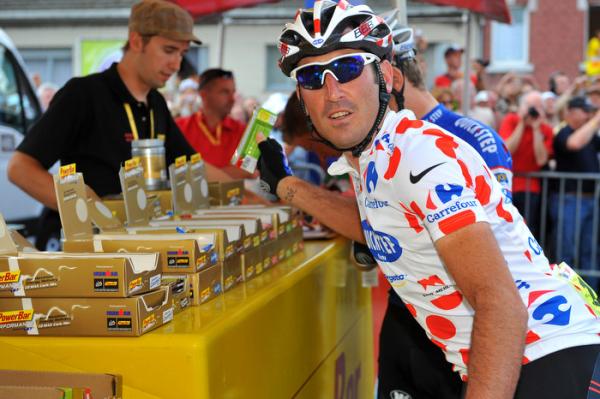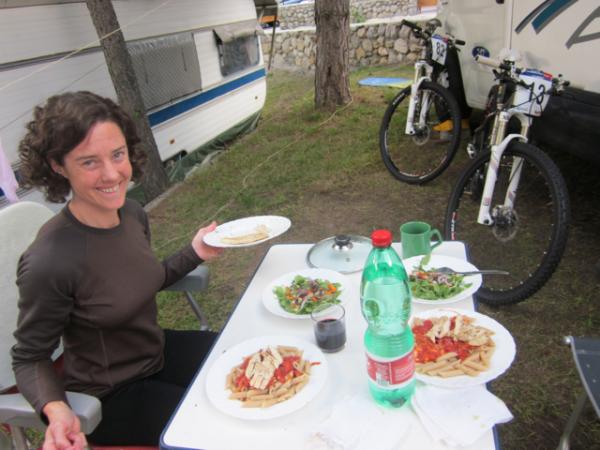Nutrition: Got enough on your plate?
Balance the key to maintaining body fuel


Correct fuelling can be the difference between a good ride and a disastrous one. We know what foods are good for us, and which we should avoid, but do we know how much of the good stuff we should be eating?
Kate Percy, sports nutritionist and author of Go Faster Food, says, "Cyclists should aim for a diet that consists of around 60 percent carbohydrate – the main source of fuel for energy, 20 percent protein – for muscle strength and repair, and 20 percent from fats – sticking to unsaturated fats to promote cardiovascular health."
The calorie count should be high enough to balance what you're using, and you should try not to consume 'empty' calories such as fizzy drinks, sweets and alcohol that won't help fuel your training.
Dietician Renee McGregor suggests the easiest way to achieve this is to fill a 10-inch plate in thirds. "A third of starchy food, a third of lean meat or fish, and a third of salad or vegetables," she says.
Although the balance of the diet will remain the same for most athletes, portion sizes will vary according to the rider's size and energy requirement. "As long as snacks and meals are healthy, varied and balanced, cyclists should, within reason, let their bodies dictate how much they eat," says Percy. Regular consumption is also a necessity, starting with the food you eat in the morning.
"There is definite truth in the saying that breakfast is the most important meal of the day," says McGregor. "By missing breakfast you aren't 'waking up' your metabolism from its overnight resting level. So when you do finally have something to eat you will be burning it up at a lower rate than if you had taken on board some vital nutrition on waking."
Morning meals that work well include muesli or porridge and wholegrain toast. "Oats and grains are excellent at releasing sugar into the blood slowly," says McGregor, "and so will keep you going until lunch."
Get The Leadout Newsletter
The latest race content, interviews, features, reviews and expert buying guides, direct to your inbox!
The calorie count of your meals should be split fairly evenly across breakfast, lunch and your evening meal, but the highest carbohydrate quantity should come in the meals that follow training sessions in order to replenish lost resources. In the days leading up to an event, when nutrition is of utmost importance, you should shift your dietary balance to incorporate more carbohydrate for more muscle fuel.
"In the 24-48 hours that lead up to a race or a sportive, a cyclist could benefit from an even steeper ratio of 70 percent carbohydrate, 20 percent protein and 10 percent fat," advises McGregor. "This will ensure that as much muscle fuel as possible is available on the event day."
Sample menu: Cod in parsley sauce
A meal of white fish with parsley sauce, boiled new potatoes, broccoli, carrots and sweetcorn, with rice pudding for dessert, breaks down into about 60 percent carbohydrate, 25 percent protein and 15 percent fat, and contains 590cals (plus 250 for pudding) – the ideal balance for a healthy cyclist.
* 115g of white fish (cod): 119cal, 25.8g protein, 1g fat, 0g carbohydrate, 0g fibre.
* 90g of parsley sauce: 88cal, 3g protein, 6.9g fat, 7g carbohydrate, 0.2g fibre.
* Four medium-sized boiled new potatoes (180g): 135cals, 3g protein, 0.5g fat, 30g carbohydrate, 2.8g fibre.
* 1tbsp olive oil: 119cals, 0g protein, 13g fat, 0g carbohydrate, 0g fibre.
* 80g of broccoli: 27cal, 2g protein, 0.3g fat, 5.6g carbohydrate, 2.6g fibre.
* 80g of carrots: 27cal, 0.6g protein, 0.2g fat, 6.4g carbohydrate, 2.3g fibre.
* 70g of sweetcorn: 79cal, 2.3g protein, 0.8g fat, 15.5g carbohydrate, 1.4g fibre.
* 100g of rice pudding: 250cal, 10g protein, 5g fat, 44g carbohydrate, 0g fibre.
Alternatives:
* Meat/fish: Skinless chicken or turkey breast, oily fish (sardines), prawns, poached eggs, tofu.
* Starchy foods: Pasta, wholewheat spaghetti, lentils, baked sweet potato, wholegrain bread, long grain brown rice.
* Vegetables: Bell pepper, rocket, red onion, boiled spinach, avocado, tomato.
Calorie Counting
To get your portion sizes right you need to know how many calories you're using.
1 Determine your base metabolic rate (BMR). Men: BMR = 66 + (6.23 x weight in lb) + (12.7 x height in inches) – (6.8 x age in years). Women: BMR = 655 + (4.35 x weight in lb) + (4.7 x height in inches) – (4.7 x age in years).
2 Multiply your BMR by the level of activity closest to what you do. Sedentary (little or no exercise): BMR x 1.2. Lightly active (light exercise/sports 1-3 days a week): BMR x 1.375. Moderately active (moderate exercise/ sports 3-5 days a week): BMR x 1.55. Very active (hard exercise/sports 6-7 days a week): BMR x 1.725. Extra active (very hard exercise/sports every day and physical job): BMR x 1.9.